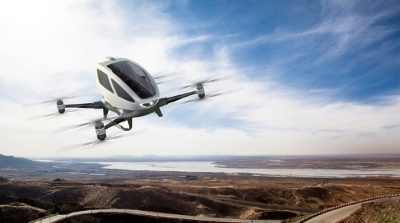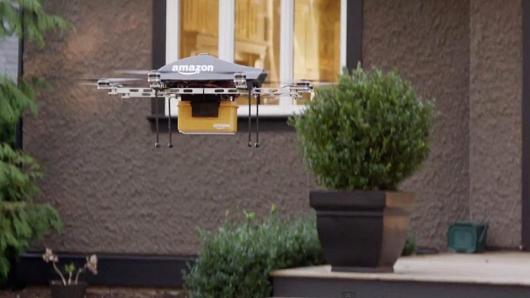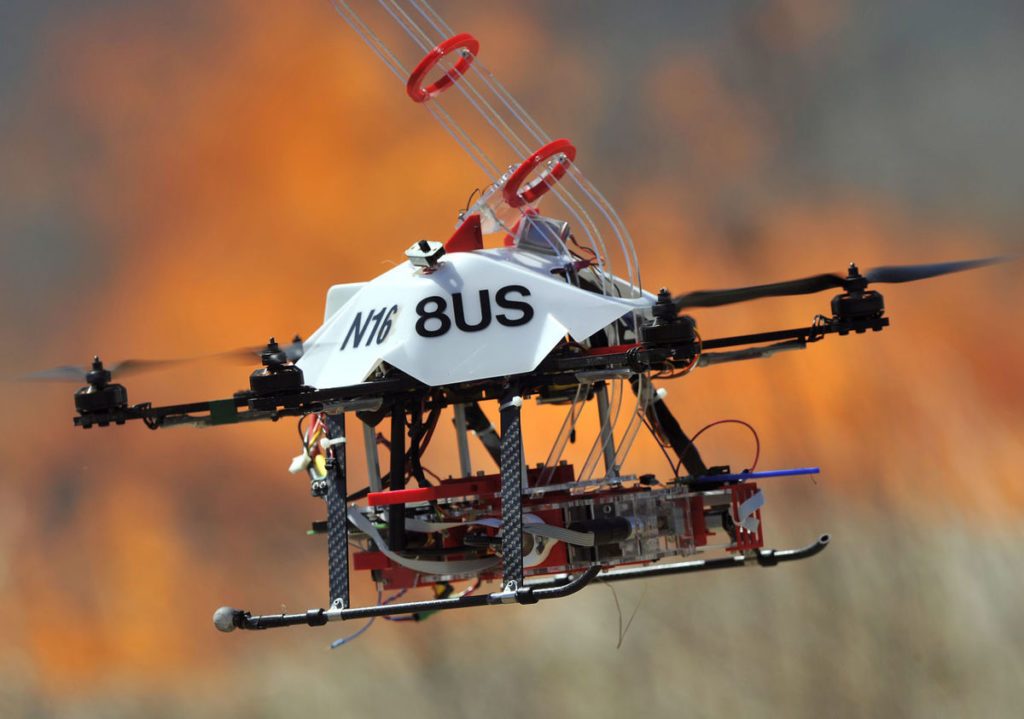Standard photography drones are expected to make record sales over the festive period. But we thought it would be a good idea to look ahead at what the industry might have to offer in the years to come. So, apart from your regular UAVs for aerial photography, what are five future uses for drones?
Personal Transport
At CES 2016, Ehang revealed the 184, a personal transport drone that looks like something out of Star Wars. If it seems like nothing more than a giant quadcopter, that’s because it is. The only difference is that there’s a small space inside designed for a passenger.
The idea is pretty simple. You order your 184, tell it where you want to go and allow the autonomous flight pilot to whisk you away to your chosen destination. Ehang has been testing the 184 already in Nevada, but we don’t know how soon it’ll be available.

But how realistic is it to imagine a world in which personal transport drones are the norm? Well, with other tech giants such as Uber also investing heavily in aerial transport, it’s a matter of when, not if. But let’s get one thing straight first of all: This kind of drone isn’t going to come cheap. It’s far more likely that if and when they are introduced to the public, it’ll be either as playtoys for the super-rich or as part of an exclusive on demand service.
Whether or not the technology is sophisticated enough to transport passengers safely in the near future remains to be seen. But the biggest hurdle facing Ehang’s big project will be one of regulation. Autonomous, beyond-line-of-sight flight is restricted by regulatory bodies around the world, while there are also weight restrictions placed on the use of commercial drones. Another issue is liability. Presuming passengers will relinquish all control to the autonomous flight system, exactly who is responsible in the event of an accident?
https://www.youtube.com/watch?v=gpSJh1EqeUQ
Verdict: Personal transport drones are a long way off, perhaps not in terms of capability, but certainly in terms of regulations.
Delivery
Several companies’ advances in drone delivery have been well publicized. Whether that’s because they are a viable business opportunity or simply free marketing material we’re still not sure. The biggest name in this emerging space is online retail giant Amazon. As part of its proposed aerial delivery service it has been testing drones in the UK.

As with personal transport, the technology is largely in place to make drone deliveries happen. The problems arise with legislative bodies still unsure where the line is between public safety and innovation. Should a single pilot be allowed to operate or supervise multiple drones from a remote location? Will the public tolerate a sky full of autonomous flying objects?
Another issue with drone delivery is one of inevitable human interference. How long will it be until someone decides to disrupt an Amazon delivery drone during the final stages of a delivery? And what will happen then? More importantly, who is responsible when things go wrong? There’s also the question of infrastructure, which will probably restrict deliveries, at least initially, to more rural areas.
Verdict: Until a bunch of fundamental questions are answered convincingly, large-scale drone delivery in urban areas will remain grounded. In the long-term future, who knows?
Fireworks
Drones are increasingly being used for the purpose of entertainment. Recently we saw a swarm of Parrot drones taking part in a UK talent competition as part of a dance act. But the most obvious use for swarms is for light displays – technology’s answer to fireworks.
Two companies pioneering in this space are Intel and Spaxels. Spaxels, from Austrian tech company Ars Electronica, are drones fitted with tiny LEDs. Intel programs them to perform synchronized performances and autonomous light shows.
These can be used for marketing and promotional displays or just straight up entertainment. Sure, they don’t have that wonderful post-firework smokey haze, but they are still pretty impressive. Intel recently broke the world record for the number of autonomous drones synchronized at once, with a whopping 500.
Verdict: Drone fireworks / light shows are happening right now. In many countries, you’ll be required to get special waivers to pull them off, but in the near future they could be more commonplace than you might expect.
Firefighting
When you combine drones and firefighting, your mind will probably flash back to all of those stories about rogue pilots interfering with firefighters’ efforts. Well, it turns out that drones can actually be used for good in the event of a fire, too.
There are two drones that we’ve seen which could have a revolutionary impact on the way emergency services deal with fires in the future.
First of all we have FAROS, which stands for Fireproof Aerial Robot System. FAROS is under development at the Advanced Institute of Science and Technology in Korea. Take a look at the video below. This is a clever drone that’s been designed to autonomously navigate through a blaze, searching for people who may have been caught up inside of buildings too dangerous to send fire crews into.
As well as streaming back a live video feed, FAROS can literally climb along walls and is completely fireproof.
Second, we have a drone that’s been designed to stop wildfires in their tracks instead of emergency services. This is a UAV under development at the University of Nebraska-Lincoln (below). It carries several small spheres full of an extremely flammable chemical powder, which are released and set off as the drone flies along a designated route. The result is a controlled burn that stops wildfires from spreading.

Verdict: Firefighting drones have the potential to change the way we deal with blazes and emergency situations. If the technology can be proven to be effective, there’s no reason why we shouldn’t see a widespread adoption of firefighting drones.
Search and Rescue
As camera drones and autonomous flight continue to progress, bespoke UAVs could have a genuinely transformative impact on the way emergency services handle search and rescue missions. One example is the drone developed by Flyability, Elios. It’s been designed to literally bounce off walls, in the same way that an insect might. It’s an aerial photography camera packed into a roll cage, able to stream a live feed from hard to reach places, such as from within the crevasse below.
Verdict: Search and Resue operations have the potential to be revolutionized by drone technology in the future. As well as allowing rescue teams to get a birds’ eye view of hard-to-reach locations, clever, durable drones such as those designed by Flyability promise to make search and rescue missions safer for all involved.
Malek Murison is a freelance writer and editor with a passion for tech trends and innovation. He handles product reviews, major releases and keeps an eye on the enthusiast market for DroneLife.
Email Malek
Twitter:@malekmurison
Subscribe to DroneLife here.







Pretty Cool, but that dramatic music…..yuck!